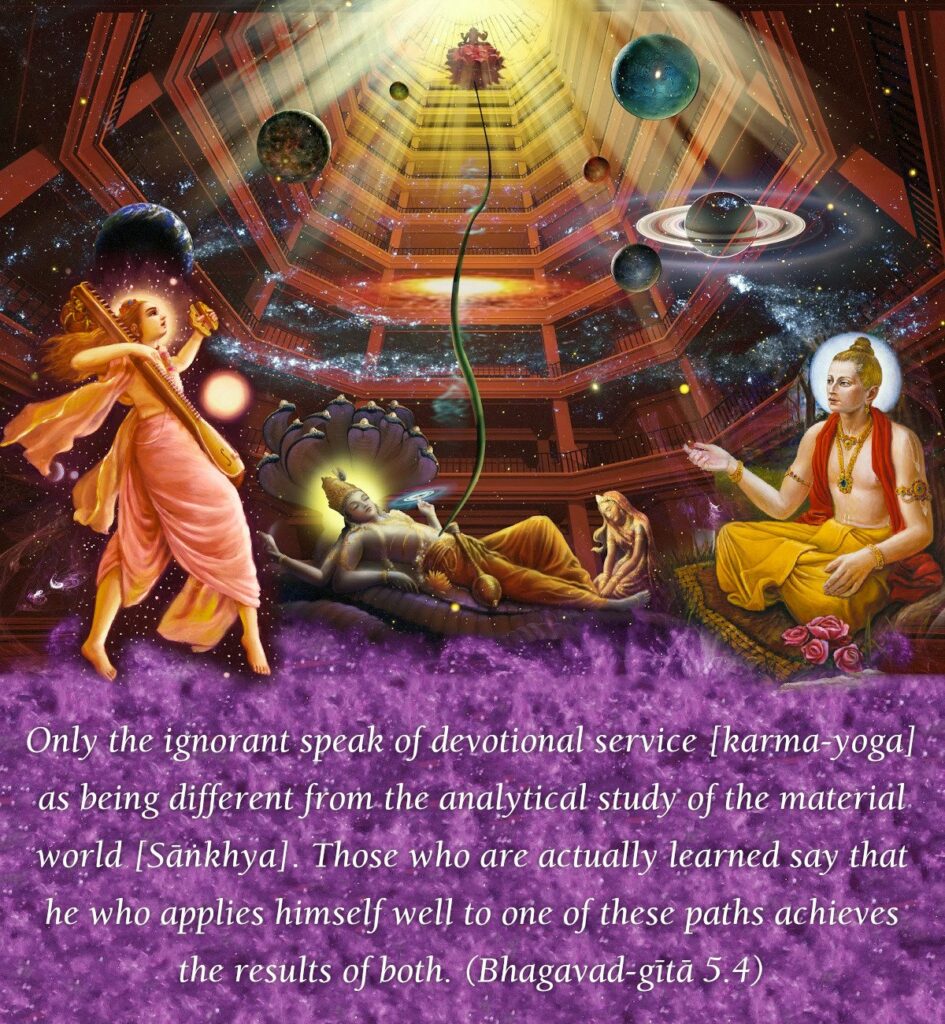साङ्ख्ययोगौ पृथग्बाला: प्रवदन्ति न पण्डिता: |
एकमप्यास्थित: सम्यगुभयोर्विन्दते फलम् || 4||
sānkhya-yogau pṛithag bālāḥ pravadanti na paṇḍitāḥ
ekamapyāsthitaḥ samyag ubhayor vindate phalam
sānkhya—renunciation of actions; yogau—karm yog; pṛithak—different; bālāḥ—the ignorant; pravadanti—say; na—never; paṇḍitāḥ—the learned; ekam—in one; api—even; āsthitaḥ—being situated; samyak—completely; ubhayoḥ—of both; vindate—achieve; phalam—the result
Translation:
Children, not the wise, say that Jnana yoga and karma yoga are distinct: He who is truly established in either of them obtains the fruit of both.
Commentary:
The Pandit mentioned here is the sage who knows the Truth and lives in it, and not a man of mere theoretical knowledge of the Sastras and the scriptures. Only the ignorant say that karma yoga and jnana yoga are distinct and separate. The Lord makes the categorical declaration that the fruit of both the yogas is the same and that the Sadhaka who takes to one of them and is well established in it, will attain the highest fruit of both. Direct perception of Atma is the aim of all yogas. Some highly evolved men follow Jnana marga. They carry on the inquiry into the real nature of things and separate the Drik (the Seer) from the Drisya (the phenomenal world) as the mythical swan is able to separate milk and water. Thus they realise Atma through Jnana marga. Others, according to their natural tendencies, take to Karma marga, and through desireless action and surrender of the fruits to the Lord, reach the same goal of Atma-sakshatkara by their purified minds. The reward of freedom, liberation, is the same for both, only the paths differ. So, in both, the seeker aims at the absorption of the ego into the Self, and thereby transcends the feeling of personal doership. When the Jiva-idea is given up, what remains is only Sivatvam and nothing else. So the Lord exhorts the aspirant to take up either of the two yogas and practice it well.
Truly established in: The condition is that the practice of any yoga should be perfect and the sadhaka should be firmly established in it. He should become an expert in the technique of the yoga which he follows. Then alone the desired result follows.
The history of the world provides many examples of great men who followed different paths and achieved the highest aim of life. The wisest of men in the Jnana marga have done the greatest service to humanity by their work. The greatest Karma yogis have always experienced Atma Jnana through a realisation of the universality of the Self in all their acts and achievements. Of course, it is quite clear that what man is aiming at is the destruction of his personal separateness from the universal, the merging of the Self in the universal Self and the realisation of the universe in his own self.
No wise man has ever disputed the truth of the different religions and creeds of the world. They practice not only tolerance but universal acceptance of all doctrines as paths to one goal. The radio of a circle reaches the centre from different positions and paths. The rivers reach the ocean through different ways. So one should give up narrowness and do not corp and cavil at those who do not follow the same path as his. Let there be a greater understanding and larger outlook in these matters which concern the people most. This is the message of the Lord.
Swami Vivekananda Says —
The yogas of work, of wisdom, and of devotion are all capable of serving as direct and independent means for the attainment of moksha. “Fools alone say that work and philosophy are different, not the learned.” The learned know that, though apparently different from each other, they at last lead to the same goal of human perfection.[Source]
Question: Are Sankhya and Karma yogas separate?
Answer: No. They appear different but produced the same fruit.
Question: What then should be the objective of the seeker?
Answer: He should sincerely practice his chosen system and get firmly established in it. He will then attain the fruit of both the yogas.
Bhagavad Gita: Chapter 5 🔻 (29 Verses)
